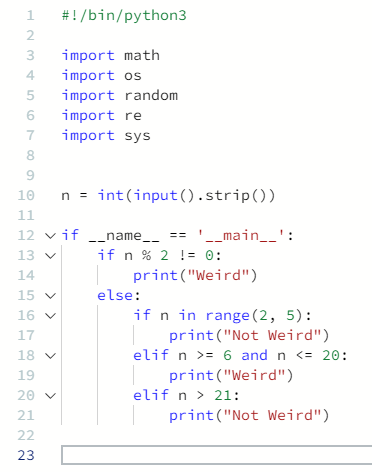Publish Date - November 4th, 2022
|Last Modified - March 7th, 2023
Hi there! Here’s my solution for the Hackerrank Python introduction for If-else! Ultimately, this an interesting test of basic Python conditionals, while providing a level of difficulty that is around EASY.
Note: In Hackerrank, I moved around the n variable input since if it’s nested in the IF statement, the browser will return no value, thereby being incorrect.
Problem
Task
Given an integer, , perform the following conditional actions:
If is odd, print
WeirdIf is even and in the inclusive range of 2 to 5, print
Not WeirdIf is even and in the inclusive range of 6 to 20, print
WeirdIf is even and greater than 20, print
Not Weird
Input Format
A single line containing a positive integer, .
Output Format
Print Weird if the number is weird. Otherwise, print Not Weird.
Sample Input 0
3
Sample Output 0
Weird
Explanation 0
n = 3
n is odd and odd numbers are weird, so print Weird.
Sample Input 1
24
Sample Output 1
Not Weird
Explanation 1
n = 24
n > 20 and n is even, so it is not weird.
The Solution
Here’s my solution (which should work)
#!/bin/python3
import math
import os
import random
import re
import sys
n = int(input().strip())
if __name__ == '__main__':
if n % 2 != 0:
print("Weird")
else:
if n in range(2, 5):
print("Not Weird")
elif n >= 6 and n <= 20:
print("Weird")
elif n > 21:
print("Not Weird")Your output should pass all of the unit tests and sample test cases afterwards when using this code above.
These types of problems are always fun and easy, since it’s just a number of conditionals. Breaking down the problem, you can easily handle each condition within the content as an IF or ELIF statement.
Given an integer, , perform the following conditional actions:
Which means that you have to provide an input and subsequent conditionals so, the already generated:
n = int(input().strip()) <- input generator for the UI and a strip() function to ensure no lead or trail spaces
and
if __name__ == '__main__': <- Function declaration.If is odd, print
Weird
The start if your conditional. The most effective way is to have python look at n and then use modulus to determine if it’s even or not (if a number is divisible by 2, that means it is even and it will always be zero). If this criteria is satisfied – print(“Weird”).
if n % 2 != 0:
print("Weird")If is even and in the inclusive range of 2 to 5 , print Not Weird
If is even and in the inclusive range of 6 to 20 , print Weird
If is even and greater than 20, print Not Weird
Next, you need to provide other statements but ensuring it’s nested after the first condition, since this first condition is essentially a master check. The rest of them are secondary checks. I used a range for the first IF statement after the modulus check then subsequently switched to arithmetic operators after.
else:
if n in range(2, 5):
print("Not Weird")
elif n >= 6 and n <= 20:
print("Weird")
elif n > 21:
print("Not Weird")Making sure you nest this second IF statement is crucial. If you don’t do this then your logic won’t have a sense of hierarchy.
Here’s the final output:

Conclusion
This is a great question to get your bearings on conditionals in Python, and get you comfortable working with an input + a function. Ultimately, it’s simple and Python can get way more complicated!
Feel free to check out my articles on related technologies:

Thank you and it helped so much….